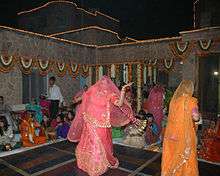Ghoomar
Ghoomar is a traditional folk dance of Rajasthan. It was Bhil tribe who performed it to worship Goddess Sarasvati which was later embraced by other Rajasthani communities.[1][2][3][4][5] The dance is chiefly performed by veiled women who wear flowing dresses called ghaghara.[6] It was ranked 4th in the list of "Top 10 local dances around the world" in 2013.[7][8] The dance typically involves performers pirouetting while moving in and out of a wide circle. The word ghoomna describes the twirling movement of the dancers and is the basis of the word ghoomar.[9][10]
 Female Ghoomar Dancers | |
| Genre | Folk Dance |
|---|---|
| Origin | Rajasthan, India |
According to the traditional rituals, newly married bride is expected to dance ghoomar on being welcomed to her new marital home.[11] Ghoomar is often performed on special occasions, such as at weddings, festivals and religious occasions.[12] which sometimes lasts for hours.
'Gangaur Ghoomar Dance Academy' was established by Maharani Rajmata Goverdhan Kumari of Santrampur in 1986, to preserve and promote Ghoomar folk dance.[13][14] The Government of India awarded her the fourth highest civilian honour of the Padma Shri, in 2007, for her contributions to arts.[15] Gulabo Sapera is the legendary dancer of Ghoomar
Origin
Ghoomar is a traditional folk dance of Bhil tribe performed to worship Goddess Sarasvati which was later embraced by other Rajasthani communities.[1][2][3][4][5] Ghoomar became popular in the Indian state of Rajasthan during the reigns of Rajput kings, and is typically performed by women during gatherings.[16] . Women perform Ghoomar with Ghoonghat on their head covering their face .
Ghoomar songs
As a traditional dance, Ghoomar often includes traditional songs such as "Gorband", "Podina", "Rumal" and "Mor Bole Re". Songs might be centered on royal legends or their traditions.
- "Chirmi Mhari Chirmali"
- "Aave Hichki" - Traditional Rajasthani Ghoomar song
- "Mhari Ghoomar Chye Nakhrali"
- "Jawai Ji Pawna" - Rajasthani folk song
- "Taara Ri Chundadi"
- "Mharo Gorband Nakhralo"
- "Naina Ra Lobhi"
- "Aur Rang De "
Gallery
 Women performing Ghoomar at wedding
Women performing Ghoomar at wedding A Rajput woman performing Ghoomar
A Rajput woman performing Ghoomar Women performing Ghoomar
Women performing Ghoomar
See also
References
- "Ghoomar or Ghumar was basically developed by the Bhil tribe and was adopted by other Rajasthani communities".
- "The song is titled 'Ghoomar', which is actually a traditional Bhil tribe folk dance, originally performed for worshiping goddess Saraswati".
- "Ghoomar, a traditional Bhil tribe folk dance".
- Kumar, Ashok Kiran (2014). Inquisitive Social Sciences. Republic of India: S. Chand Publishing. p. 93. ISBN 9789352831098.
- Danver, Steven L. (June 28, 2014). Native People of The World. United States of America: Routledge. p. 522. ISBN 076568294X.
- http://www.rajasthantour4u.com/blog/index.php/2009/06/28/ghoomar-famous-social-folk-dance-of-rajasthan/ Ghoomar - Famous Social Folk Dance of Rajasthan
- "Ghoomar in top 10 list of world's most amazing local dances". Business Standard. 23 July 2013. Retrieved 22 June 2017.
- "Top 10 local dances around the world". Hindustan Times. 8 July 2013. Retrieved 22 June 2017.
- "Ghoomar Dance, Rajasthan". Archived from the original on 2012-05-18.
- "Ghoomar Dance - Rajasthan". rajasthanvisit.com. Retrieved 11 August 2016.
- Indian States At A Glance 2008-09: Performance, Facts And Figures - Rajasthan - Bhandari Laveesh (2008-09)
- "Ghoomar in India". Retrieved 2 December 2016.
- "Image Details". India Today. June 6, 2007. Retrieved August 25, 2016.
- "Rajmata Goverdhan Kumari". Indian Institute of Management, Ahmedabad. 2016. Archived from the original on November 17, 2015. Retrieved August 25, 2016.
- "Padma Awards" (PDF). Ministry of Home Affairs, Government of India. 2013. Archived from the original (PDF) on November 15, 2014. Retrieved August 20, 2016.
- https://www.rajasthandirect.com/culture/dance/ghoomar
External links
- An example of Ghoomar - Veena Music YouTube Channel